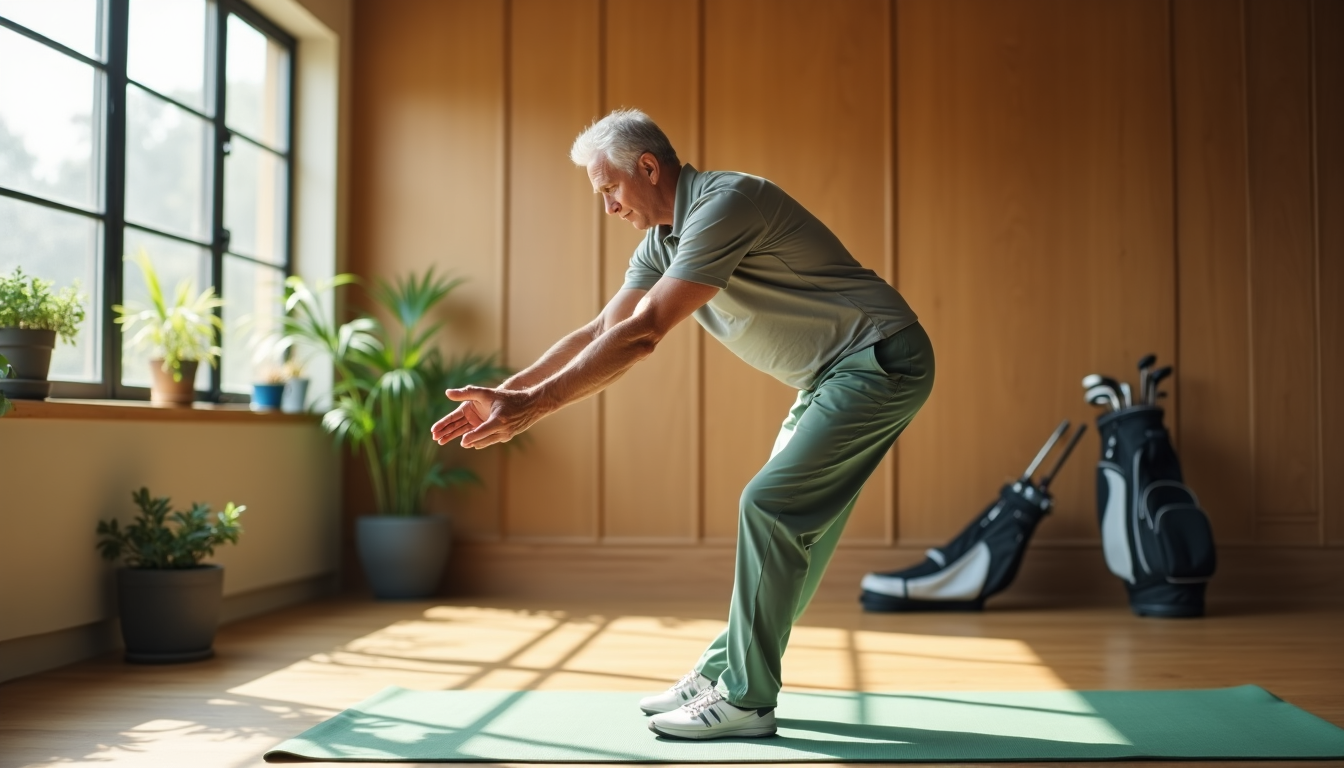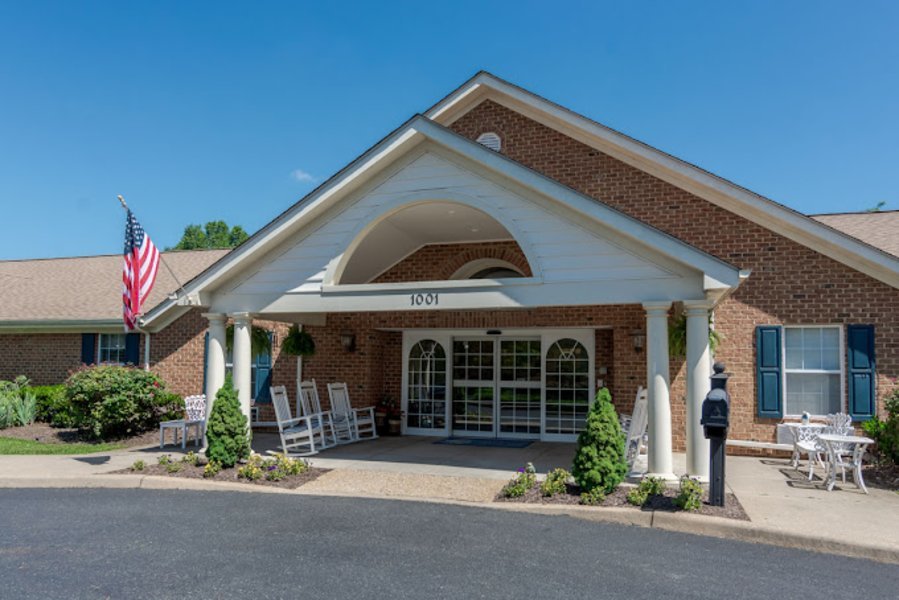Did you know that 70% of senior golfers lose distance in their drives after turning 50?
Age isn’t the only culprit here – decreased flexibility and strength play a big role, and we can actually turn things around with proper exercises. Senior golfers often struggle when stiff joints slow down their game. Lower energy levels and reduced mobility affect their performance, but here’s the good news: the right golf exercises can help reverse these effects.
Senior golfers face unique challenges on the course. This piece offers golf stretches and flexibility exercises that work perfectly for older players. You’ll discover essential warm-up routines and golf swing exercises to improve your power and control. These techniques will help you maintain or even boost your performance naturally.
Want to add more yards to your drive and play without pain? These proven golf exercises for seniors will reshape your game completely.
Understanding Senior Golf Fitness Needs
Our bodies go through many changes as we age that affect our golf game. We’ve noticed these physical limitations aren’t just about getting older – they often happen because we’re not active enough. The good news is we can make things better with the right exercise.
Age-Related Changes Affecting Golf Performance
Let’s look at the main physical changes that affect how we play golf:
- [Flexibility Reduction](https://seniorsite.org/resource/essential-exercises-programs-for-senior-health-and-mobility/): Our muscles and joints naturally become less flexible, especially in the hips, shoulders, and spine. This affects how well we can rotate during our swing
- Muscle Mass Decline: We naturally lose muscle mass (sarcopenia), which leads to slower swing speeds and shorter drives
- Balance Issues: Our coordination and stability get worse, making it hard to keep proper stance
- Endurance Limitations: Playing a full round becomes more challenging
Benefits of Golf-Specific Exercise Programs
Golf exercises for seniors can boost both performance and enjoyment of the game. Regular practice offers several advantages:
Physical Benefits:
- Better brain function and focus
- More stability and fewer risks of falling
- Stronger muscles and more energy
- Better flexibility and movement range
These exercises don’t just help your golf game – they make your whole life better. Studies show that golf-specific training helps prevent muscle loss and improves heart health.
Assessing Your Current Fitness Level
You need to check your current fitness level before starting any golf exercises. This helps create an exercise program that fits your needs. Here’s what we measure:
Core Components:
- Aerobic Fitness: How well your heart works
- Muscle Strength: Your power generation in the swing
- Flexibility: Your movement range in key golf positions
- Balance: Your stability in different stances
A complete fitness check should measure your resting heart rate, basic flexibility, and simple balance exercises. You should talk to a healthcare professional or certified golf fitness instructor. They can properly check these areas and help design a safe, effective program.
Note that our goal isn’t just about playing better golf – it’s about staying active and healthy so we can enjoy the game longer. Understanding and working on these fitness needs helps us maintain or even improve our game on the course.
Essential Pre-Exercise Safety Guidelines
Safety should be your top priority when you start a new exercise program. This is especially true for senior golfers. Let’s look at the key guidelines that will help you exercise safely and get results.
Medical Clearance and Health Considerations
A visit to your healthcare provider should happen before you begin your golf exercise routine. This step becomes vital if you have existing conditions or take medications. Your consultation should cover:
- Your current activity level
- Physical limitations you may have
- Specific recommendations about exercise intensity
- Any concerns about joint issues
Proper Warm-Up Techniques
The right warm-up can make a big difference in your performance. Studies show that dynamic stretching and low-resistance exercises can help you hit the golf ball up to 45 yards further. A good warm-up should:
- Use dynamic stretches instead of static holds
- Include light resistance movements
- Last at least 10 minutes
- Focus on golf-specific muscle groups
Important Note: Static stretching can reduce your strength by up to 28%. Light resistance exercises, however, can boost your power output by 14%.
Equipment and Space Requirements
You need enough space and the right equipment to exercise safely. Here’s what your setup should have:
- Minimum Space Requirements:
- Width: 9-10 feet gives you comfortable swinging room
- Depth: 14-18 feet allows full movement
- Height: 10 feet minimum ceiling clearance
Your basic equipment should include:
- Resistance bands with the right tension
- Non-slip exercise mat
- Loose, comfortable clothing
- Shoes with good arch support
Equipment safety needs regular attention. Check your resistance bands for damage often. Keep your exercise area well-lit and ventilated. Make sure the floor stays clear of anything that might trip you up.
These guidelines do more than prevent injuries. They create a safe space where you can work on your golf game and stay healthy at the same time.
Core Golf Flexibility Exercises
These flexibility exercises will help you maintain and improve your golf performance. We picked these movements because they work well for senior golfers.
Upper Body Rotation Drills
A powerful golf swing depends on how well you can rotate your body. The Helicopter Drill is a basic exercise that helps develop thoracic mobility. Here’s what you need to do:
- Stand with arms extended at shoulder height
- Keep feet shoulder-width apart
- Rotate your torso from ground up
- Let your arms follow the rotation naturally
- Keep breathing steady throughout
This drill helps you develop “connected rotation” where your upper body moves smoothly with your lower body. This creates more consistent swing patterns.
Hip Mobility Exercises
Your hips play a vital role in generating power for your golf swing. The 90-90 Hip Mobility exercise works really well for senior golfers. Good hip mobility can add distance to your drives and reduce strain on your lower back.
Hip mobility work gives you these benefits:
- Better weight transfer during swing
- More rotation in backswing
- Improved follow-through capability
- Less risk of lower back strain
Spine Flexibility Routines
We keep our spine flexibility exercises gentle but effective. The Open Book stretch helps improve thoracic rotation. Just lie on your side, extend one arm, and rotate your upper body while keeping your legs stable.
Note that you should always stay within your comfortable range of motion. Regular practice of these exercises will improve your:
- Overall swing mechanics
- Shot accuracy
- Playing endurance
- Post-round recovery
Just 10-15 minutes of these flexibility exercises before each round makes a big difference in your game. Make these movements part of your regular golf routine, just like putting practice or equipment checks.
Building Golf-Specific Strength
Golf-specific strength training targets the muscles used most during a swing. Research shows that maintaining muscle mass becomes crucial after age 50, since people lose 3-5% of their muscle mass each decade.
Grip and Forearm Exercises
Strong hands and forearms help you control your swing effectively. A proven sequence of grip-strengthening exercises includes:
- Towel Wrings: Hold a towel at both ends and twist in opposite directions
- Club Rotations: Hold a club at its center, rotating wrists slowly
- Resistance Band Pulls: Wrap band around fingers, spread against resistance
- Wrist Flexions: Support forearm on knee, curl wrist up and down
Core Strengthening Movements
The core acts as the power center for a golf swing. Strong, active muscles in the mid-region help execute a swing that combines power and technical precision. Core training provides these benefits:
- Improved swing posture maintenance
- Enhanced downswing consistency
- Better rotational power
- Reduced risk of lower back strain
The Plank-to-Rotation exercise serves as the life-blood movement. Starting in a plank position, rotate the upper body while maintaining stability. This movement mirrors the controlled rotation needed in a golf swing.
Lower Body Power Development
A better golf game starts from the ground up. The focus lies on exercises that develop “ground force reaction” – power that transfers from legs through the core to the club.
The Golf Squat builds optimal lower body strength by mimicking the stance position. Players stand with feet shoulder-width apart and lower themselves while maintaining their golf posture’s spine angle. This builds stability needed for consistent drives.
The Single-Leg Bridge works especially when you have to improve hip strength and stability. Strengthening one side at a time develops balanced power for proper weight transfer during swings.
Note that this approach builds functional power that directly improves golf performance. Each exercise serves a specific purpose, from the grip pressure needed for precise putting to the leg drive required for powerful drives.
Creating Your Progressive Exercise Plan
A well-laid-out exercise plan needs to align with your individual needs and goals. Our work with senior golfers has led us to develop a method that delivers steady progress. You will stay safe and enjoy the process.
Beginner to Advanced Exercise Progression
Starting where you are and moving at your own pace makes sense. Our tested progression system has these steps:
- Foundation Phase (Weeks 1-4)
- Master proper form and simple movements
- Build core stability and simple flexibility
- Create consistent workout habits
- Development Phase (Weeks 5-8)
- Take on more complex exercises
- Begin resistance training
- Boost movement patterns
- Performance Phase (Weeks 9-12)
- Add golf-specific movements
- Step up exercise intensity
- Develop power
Weekly Workout Schedule Templates
Results come from consistency. Our weekly schedule gives you the right mix of exercise and recovery:
Monday: Upper body flexibility and core exercises Wednesday: Lower body strength and balance work Friday: Full-body mobility and golf-specific movements
Pick the same time each day for your workouts. Early morning sessions work best for some people, while others prefer exercising before dinner. The right time depends on your schedule.
Tracking Progress and Adjusting Intensity
These performance indicators tell us if you’re on the right path:
- Physical Measurements
- Shoulder and hip range of motion
- Core strength endurance
- Balance duration
- Swing speed improvements
A workout journal helps track your progress. You can spot areas that need work and celebrate your wins. The program intensity changes based on your results. You move up when you complete all sets with good form for three sessions in a row.
Your body knows best. Scale back or take an extra rest day if you feel unusual fatigue or discomfort. Progress isn’t always straight forward. Some weeks bring big improvements, others focus on maintaining what you’ve gained.
Look at your program every 4-6 weeks. This helps make needed adjustments based on your progress and keeps exercises challenging. A certified golf fitness instructor can give you valuable tips during these assessments and refine your technique.
This all-encompassing approach to golf fitness does more than just exercise you. It builds a foundation for better performance on the course. Each session moves you closer to improved flexibility, strength, and more enjoyable rounds of golf.
Conclusion
Age doesn’t have to affect your golf fitness. Our detailed approach to golf exercises shows that players can maintain and improve their performance through targeted training. Senior golfers who stick to well-laid-out exercise programs hit the ball farther, become more flexible, and enjoy their game more.
The exercises create a complete system. This includes everything from warm-ups and flexibility routines to strength training and progressive workout plans. We found that there was a notable difference in golf performance when players spent just 30 minutes exercising three times weekly.
Note that consistency and proper form matter more than intensity. Players build lasting improvements in their game when they start slow, track progress, and increase difficulty step by step. These proven exercises and attention to proper technique help golfers hit powerful, accurate shots well into their golden years.




